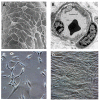Human Vascular Pericytes and Cytomegalovirus Pathobiology
- PMID: 30909422
- PMCID: PMC6471229
- DOI: 10.3390/ijms20061456
Human Vascular Pericytes and Cytomegalovirus Pathobiology
Abstract
Pericytes are multipotent cells of the vascular system with cytoplasmic extensions proximal to endothelial cells that occur along the abluminal surface of the endothelium. The interactions between endothelial cells and pericytes are essential for proper microvascular formation, development, stabilization, and maintenance. Pericytes are essential for the regulation of paracellular flow between cells, transendothelial fluid transport, angiogenesis, and vascular immunosurveillance. They also influence the chemical composition of the surrounding microenvironment to protect endothelial cells from potential harm. Dysregulation or loss of pericyte function can result in microvascular instability and pathological consequences. Human pericytes have been shown to be targets for human cytomegalovirus (HCMV) infection and lytic replication that likely contribute to vascular inflammation. This review focuses on human vascular pericytes and their permissiveness for HCMV infection. It also discusses their implication in pathogenesis in the blood⁻brain barrier (BBB), the inner blood⁻retinal barrier (IBRB), the placenta⁻blood barrier, and the renal glomerulus as well as their potential role in subclinical vascular disease.
Keywords: HCMV; brain; cytomegalovirus; endothelial; inflammation; ocular; pericyte; placenta; renal; vascular.
Conflict of interest statement
The author declares no conflict of interest.
Figures



References
-
- Eberth C.J. Handbuch der Lehre von der Gewegen des Menschen und der Tiere. Volume 1 Engelmann; Leipzig, Germany: 1871.
-
- Rouget C. Me’moire sur le de´veloppement, la structure et les propriete´s physiologiques des capillaires sanguins et lymphatiques. Arch. Physiol. Norm Path. 1873;5:603–663.
-
- Zimmermann K.W. Der feinere Bau der Blutkapillaren. Z. Anat. Entwicklungsgesch. 1923;68:29–109. doi: 10.1007/BF02593544. - DOI
Publication types
MeSH terms
Grants and funding
LinkOut - more resources
Full Text Sources
Medical

